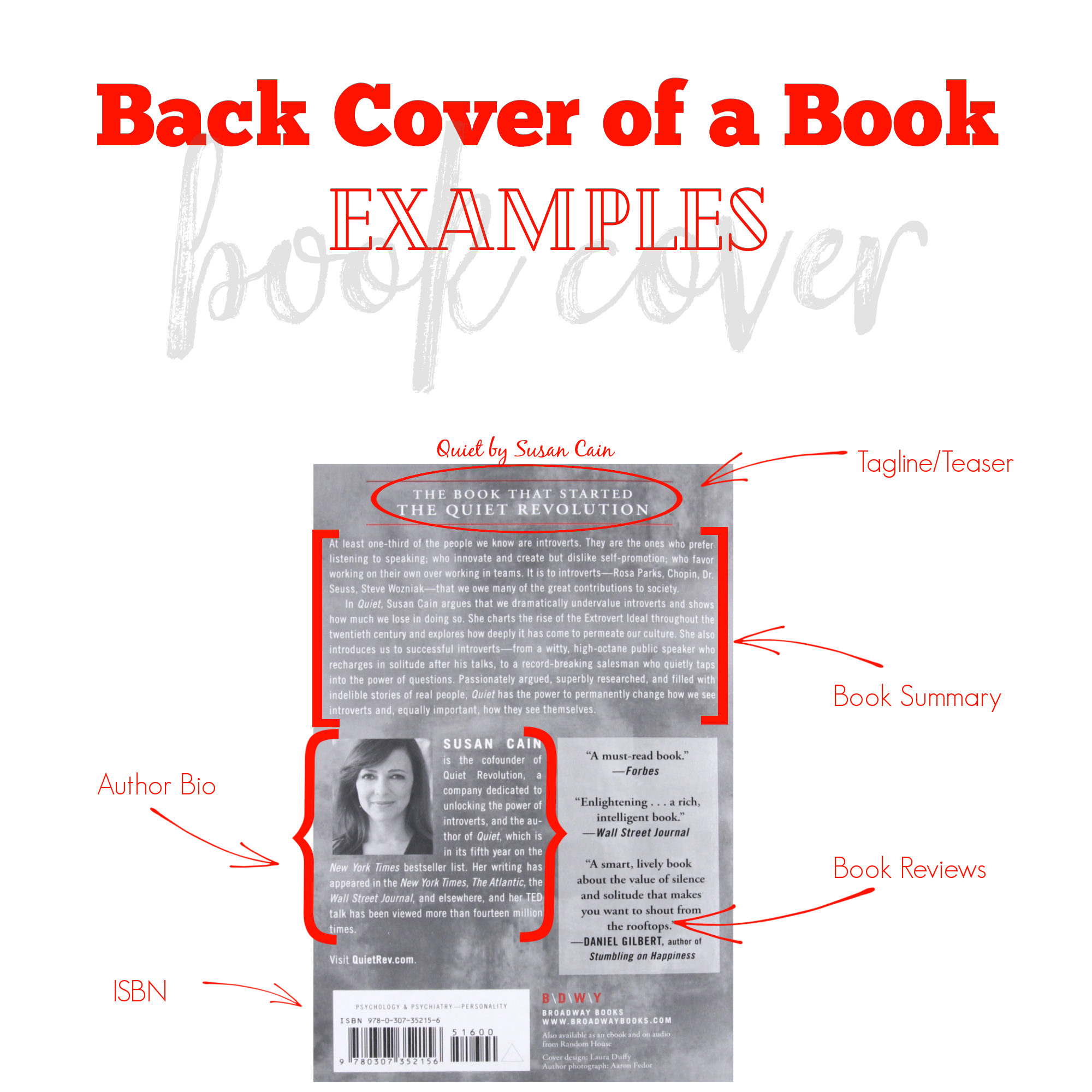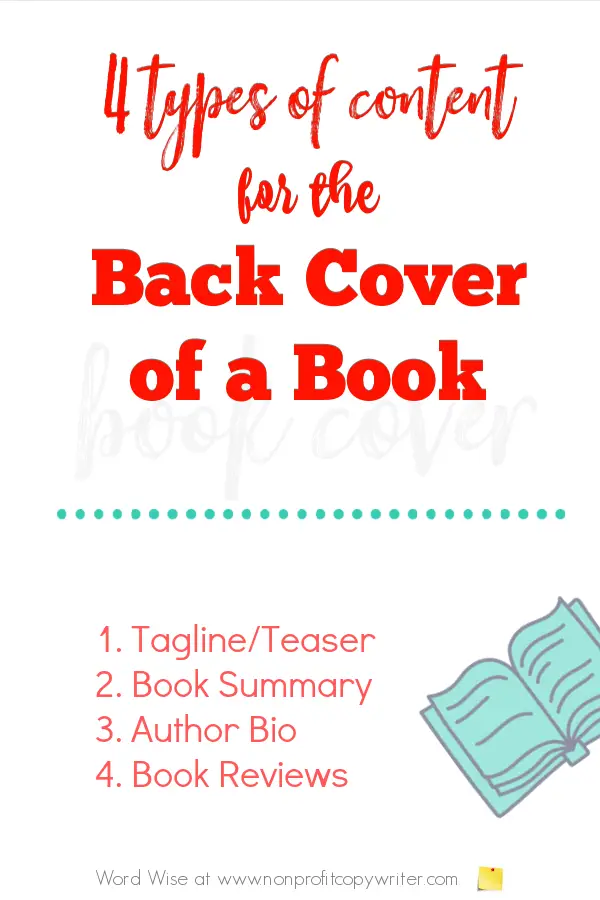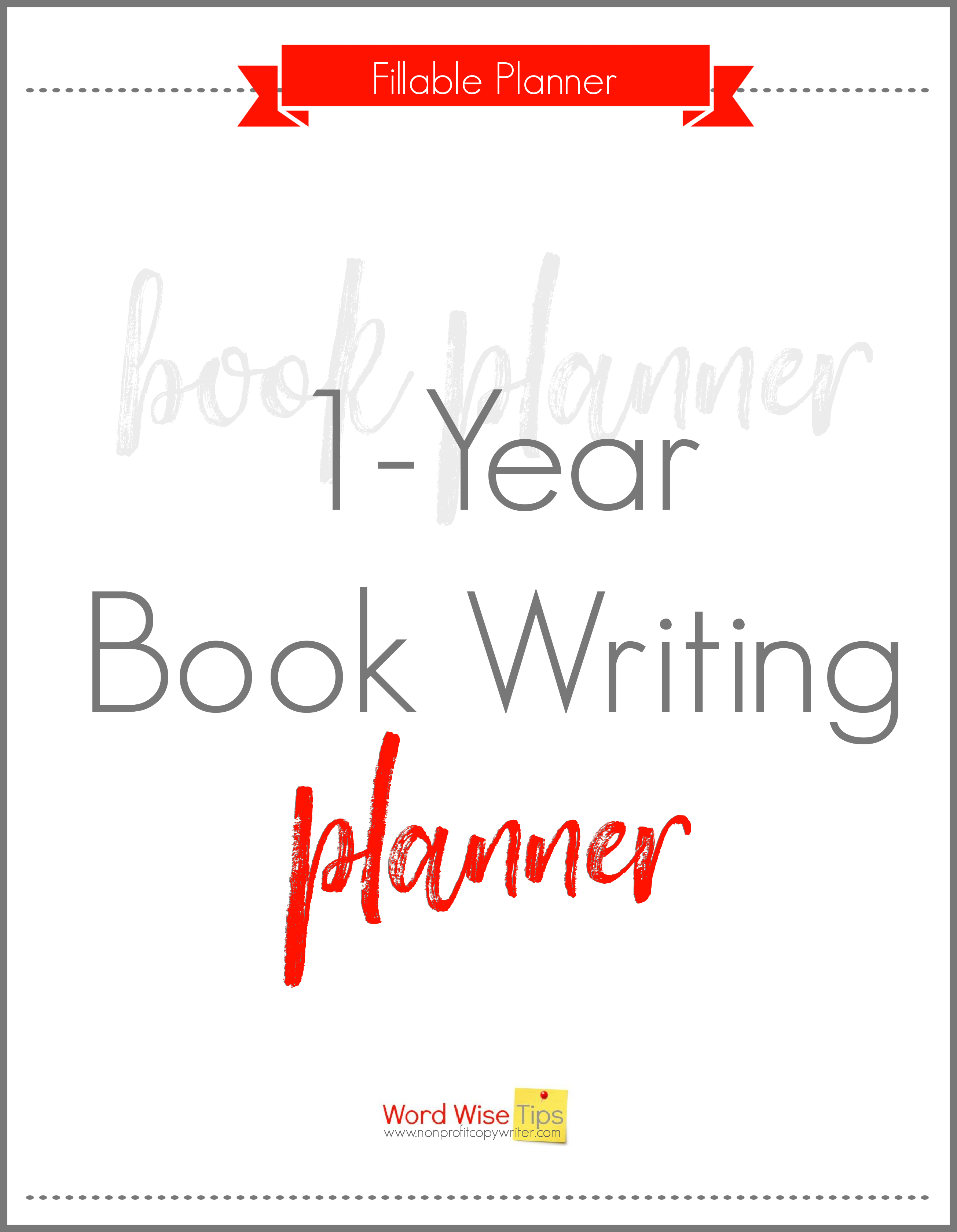Save Time: Get 5 Simple Writing Tips
you can put to use in 10 minutes
What Goes on the Back Cover of a Book?
Award-winning writer Kathy Widenhouse has helped hundreds of nonprofits and writers produce successful content , with 750K+ views for her writing tutorials. She is the author of 9 books. See more of Kathy’s content here.
Updated 12.29.2023
What goes on the back cover of a book? I’m not talking about design. Both the front and back cover of a book need quality graphics and typography to pull in readers.
And when it comes to look and feel, the front and back cover of a book should complement one other. Hexadecimal color codes or serif fonts versus sans serif fonts are important considerations. But all that artistic mumbo-jumbo lands smack in a designer’s arena.
But what about the content on the back cover of a book? Clearly, it’s important. You’ve seen the scenario dozens of times in a bookstore or library. A reader plucks a book from the shelf and scans the cover. Intrigued, she flips it over to read more on the back. Now, she’s truly interested. So much so that she opens the book to inspect the table of contents …
“The front cover gets them interested,” says Tucker Max, 4-time NYT best-selling author. “Then the back cover helps the reader decide whether or not they want to go any further.” You want to help that decision in your favor, don’t you?
Four pieces of content grace the back cover of a book. How you write yours helps readers step over the line and decide, “Yes! I most certainly MUST read this.”
Use these tips as you write the back cover of your book so prospective readers place your book on their not-to-miss list.
4 types of content for the back cover of a book
1. Tagline or teaser
Whether you write a tagline or a teaser, readers are drawn to this short snippet on the back of your book. Your designer will likely place it in a large font – one that pops out. Do your part to make your teaser or tagline earn their keep. Treat this content like a headline to draw in readers.
- Writing nonfiction? Use a tagline at the top of the back cover. A tagline is a short (5–10 word), descriptive phrase that defines your book. It highlights the problem your book addresses and your promise to solve it. (This worksheet guides you through the process of writing a tagline.)
- Writing fiction? Use a teaser. It could a quote from your main character or short version of your book’s main description. Your teaser introduces the character’s problem and a twist that happens as they face that challenge. Keep your teaser to 50 words or less – preferably shorter, since you’ll unpack the plot in your book summary.
2. Book summary
What do you call the summary on the back of a book? Some publishers refer to it as back cover copy because it’s written to persuade. Occasionally it’s referred to as flap copy, given that it’s printed on a hardcover’s dust jacket.
No matter what you call it, the book summary is the most-read element on the back cover of a book.
Here’s the key tip to remember as you write the book summary: it’s not a synopsis. Instead, your blurb on the back of the book shows the reader what the book will do for her.
- A nonfiction book jacket blurb describes a problem a reader faces and gives a brief list of ways the book helps her solve it, often in a bullet list of 3-7 points. Use it to tell your reader how her life will be better and different after reading the book and give a call to action.
- A fiction back jacket blurb presents the main characters, the problem they face, and stakes in not solving it. Who is your protagonist? What problem does he face? What other key characters are involved in the conflict? What kind of action takes place to lead to a resolution?
How long should your book summary be? About 150-200 words. No more. Remember – this is just one element on the back of your book. And you don’t want to give away the store. You want your book summary to intrigue or entice the reader to read the book.
And your book summary can do double duty. You can use it as an elevator speech as you talk about your book with editors, agents, promoters, and on social media.
3. Author bio
Why are you the person to write this book? Note that I didn’t ask if you’re the ONLY person who was able to write the book. These days, anyone can put words on paper and paper into a print-on-demand or Kindle edition.
But consider why you’ve done so. It’s in these 100 words or less you need to tell the reader a personal or specific reason you can speak with authority about the content in your book.
- Experience. If you faced the problem the book addresses, say so. Readers need to know that you were downsized out of a job after 15 years and started a lucrative business. Your personal history gives your book more credibility.
- Credentials. If you have special qualifications or credentials, say so. Your book about homeschooling has special significance when you mention the 14 years that you spent in your home teaching your three children. If your book is about bird watching, mention your Ph.D. in wildlife management.
- Personal motivation. If personal facts are important to the book, say so. Your book about building a family legacy means more when readers see you have a wife, four kids, and ten grandkids. If the book is about fly fishing, explain that you’ve been using your waders and casting flies for three decades.
- Backlist. If you’ve written other books, say so. Readers appreciate writers that have successfully published … and then proceeded to do it again.
Your designer may also ask you for a headshot to incude in your author’s bio.
4. Book reviews
Book reviews are gold – especially if the reviewer has notoriety or qualifications. If you’re fortunate enough to have beta readers review your book, pull a few choice comments and include them on the back cover of your book. You can even get book reviews for free.
Use this 1-Year Book Planner to get your book done.
One more thing that goes on the back cover of a book
Flip over any hardcover or paperback and on the back cover, you’ll see a barcode representing the book’s ISBN (International Standard Book Number.) It is a unique 13-digit number assigned to a book that allows for accurate and efficient tracking. How do you get one for your book?
- If your book publication is handled by a publishing house, your editor will procure an ISBN for you.
- If you publish through Kindle Direct Publishing, Amazon can assign your book a free ISBN.
- If you publish through a service such as BookBaby, the service will assign your book an ISBN for a small fee.
Be aware that your book’s ISBN and the barcode are two different things. The ISBN is an actual number. The barcode is a visual representation of that number – one that is scannable.
Back cover of a book examples
Take a look at the different elements on this back cover of a book so you have a few ideas as you write your own.

More tips for writing a book
Use this Self-Publishing Checklist for a Winning Amazon Release ...
Top Tip for Selling Your Book ...
Write a Book Subtitle That Sells Your Book ...
The Back Matter of a Book: What to Write After You Write “The End..."
Need to Write a Title for Your Book? Try This...
How to Write a Book Summary that Sells Your Book ...
How to Use a Personalized Book Writing Plan to Get Your Book Done ...
How to Get Book Reviews For Free ...
How to Publish a Book for Free...
5 Places to Find Book Ideas ...
Test Your Book Idea with These 4 Questions ...
Getting Started Writing a Book ...
Book Writing Help: Choose a Publishing Platform ...
Writing eBooks: Frequently Asked Questions ...
See more tips for Writing a Book on my Pinterest board...
Return from What Goes on the Back of a Book Cover? to Nonprofit Copywriter home
As an Amazon Associate I earn from qualifying purchases.
Share This Page

Named to 2022 Writer's Digest list
BEST GENRE/NICHE WRITING WEBSITE


Stop Wasting Time!
Grab your exclusive FREE guide, "5 Simple Writing Tips You Can Put to Use in 10 Minutes or Less"













